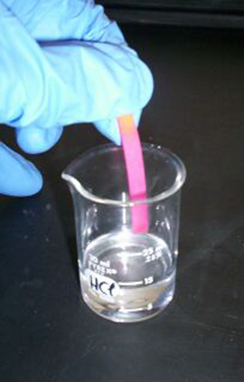| << Chapter < Page | Chapter >> Page > |

In chemistry, pH is used as a measure of the acidity or alkalinity of a substance. The pH scale runs from 0 to 14. Substances with a pH less than 7 are considered acidic, and substances with a pH greater than 7 are said to be alkaline. Our bodies, for instance, must maintain a pH close to 7.35 in order for enzymes to work properly. To get a feel for what is acidic and what is alkaline, consider the following pH levels of some common substances:
To determine whether a solution is acidic or alkaline, we find its pH, which is a measure of the number of active positive hydrogen ions in the solution. The pH is defined by the following formula, where is the concentration of hydrogen ion in the solution
The equivalence of and is one of the logarithm properties we will examine in this section.
Recall that the logarithmic and exponential functions “undo” each other. This means that logarithms have similar properties to exponents. Some important properties of logarithms are given here. First, the following properties are easy to prove.
For example, since And since
Next, we have the inverse property.
For example, to evaluate we can rewrite the logarithm as and then apply the inverse property to get
To evaluate we can rewrite the logarithm as and then apply the inverse property to get
Finally, we have the one-to-one property.
We can use the one-to-one property to solve the equation for Since the bases are the same, we can apply the one-to-one property by setting the arguments equal and solving for
But what about the equation The one-to-one property does not help us in this instance. Before we can solve an equation like this, we need a method for combining terms on the left side of the equation.
Recall that we use the product rule of exponents to combine the product of exponents by adding: We have a similar property for logarithms, called the product rule for logarithms , which says that the logarithm of a product is equal to a sum of logarithms. Because logs are exponents, and we multiply like bases, we can add the exponents. We will use the inverse property to derive the product rule below.
Given any real number and positive real numbers and where we will show

Notification Switch
Would you like to follow the 'Precalculus' conversation and receive update notifications?